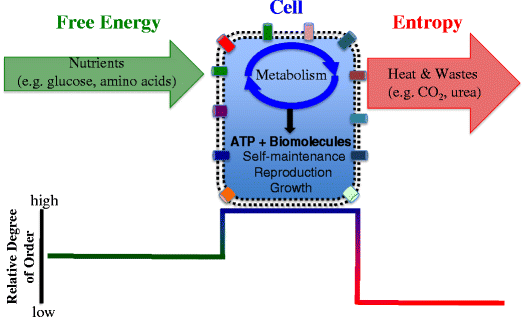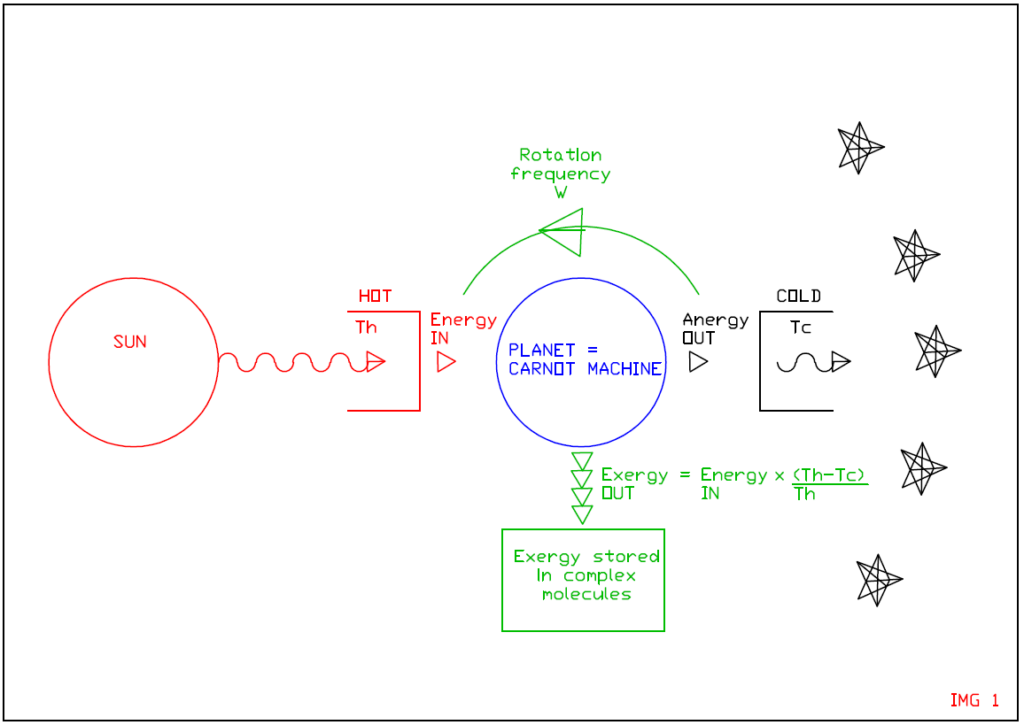The antidarwinistic principle of thermodynamic

Life is such a rare and precious thing, but is it really?
The answer to this question is: NO, not really…
Far from being rare, life is pretty much everywhere on each and any observed solar system, you only need to throw a rock around any star out there, wait long enough and come back to find out that some small and primitive life forms have developed on the surface of that rock.
What was observed from the laws of thermodynamic is that Entropy always increases all the time, which means life is a fight against unbeatable thermodynamic odds, hence a very rare thing to come across.
But according to other researchers, life might in fact be that flexible medium which favors and eases the overall increase of Entropy of a given system as opposed to a system without it, so its development is as spontaneous and uninteresting event like a rock naturally rolling down a hill under the influence of gravity.
To go back to that rock orbiting around that faraway Sun, we know that one side of the rock will be in daylight and hot (daylight average temperature = Th, HOT), the other side of the rock will be exposed to the cold night side of the universe (average night temperature = Tc, COLD).
If the rock wasn’t there, the Sun would be happily spreading its hot and low entropy (electromagnetic radiation) out to the cold outer space (high entropy), but our rock is right in the middle, causing a resistance to the spread of increasing entropy and light to the outer space.
Then in this case life will arise out of thermodynamic necessity on that rock to try to fix things out and accelerate the rate of dispersion of heat from the hot side out to the cold side of our rock.
By having an alternating day and night time (hot and cold cycle), we have all we need to build a Carnot machine capable of delivering a certain amount of free energy (entropy decrease, exergy), if only there was something there to capture and make use of this energy available…

What was in fact demonstrated is that this exergy portion of the initial energy input from the Sun will eventually condense into more complex/higher energy molecules. Of all the complex molecules which can and will be generated by this planetary Carnot machine, those that are more capable of storing hot energy in the day and release it back to the night side are in fact the more thermodynamic efficient ones, whose formation will be favored into the system as opposed to other less efficient molecules.
All this complex molecule formation game is in fact dictated by the thermodynamic necessity of reducing the entropic resistance of the rock, preventing the Sun from shining through and increase the universe entropy at faster rates.
In this perspective, an ever more complicate molecule that eventually develops the capability of breaking apart and splitting (thus replicating itself!) will be more efficient than other “non replicating” type molecules.
On this primordial life soup of complex molecules with some degree of self-replicating capabilities, not just one type of molecules will develop but different kinds of molecules depending on local gradients of temperatures and chemical elements available.
Of all these molecules some will be “fitter than others” and multiplying at greater rate than other complex molecules, so the seed of diversification is born at the same time with this primordial living environment.
Now we have the basic principle of life in the sense that it emerges spontaneously out of thermodynamic necessity wherever there is some energy to spare, it copies itself over into ever growing networks of complexity and symbioticity and it can handle and process more energetic processes within the environment it inhabits.
In this new perspective we can safely say that burning fossil fuels is something physically and thermodynamically expected of us as humans.
What we have forgotten to mention so far is any reference to liquid water, nor oxygen in the atmosphere, nor acceptable temperatures, all common arguments for the existence of carbon-based type life.
In the light of the antidarwinistic principle of thermodynamic, life will spring into existence using whatever media and molecules are locally available at the locally available average temperature and pressure.
So despite the surface of Saturn being kinda chilly in winter (like -200 deg C) and saturated with hydrocarbons and ammonia at many bars of (Earth) atmospheric pressure, it might still feel pretty good for the local Saturnian life basking in the sun at a local beach in front of a sea of pure liquid methane.
In fact for the Saturnian people, the Earth might seem way too close to the Sun which means the temperature there would be unbearably hot, also the air would feel pretty thin and the free oxygen for them is the strongest oxidant and poison to them.
How was it possible for human life to develop into such an inhabitable planet like the Earth with such an unlikely chemistry available on its surface?
Not every planet is created equal
Having said that, some places are better than others for the formation of life, depending on gravity and light conditions. The development of complex molecules and associated life might be hampered if the day cycle is too slow or nonexistent then the available power of planetary the Carnot machine is 0 if the cycle speed of day duration is 0.
Other planets don’t have enough gravity to retain an atmosphere or liquid masses, so mass transfer is very limited and so molecular mobility, then the development of life will be much slower or so slow to be nonexistent as measured by faster life forms developed in more efficient planet incubators.
A good planet must have a decently fast day cycle time which means higher power available from the Carnot machine. It must provide a generous temperature gradient between the day and night zone which means more efficient Carnot cycle, and it must have some sort of permanent liquid zones on its surface to act as an incubator and protective bed for the generation of complex molecules within it. Also life could be seeded onto primordial planets and different cocktail of molecules be seeded to test out diversity and evolution against different planetary backgrounds and to study and learn which evolutive loops will be more successful than others and provide better classifications of planet types and associated life types possible on these alien environments.
